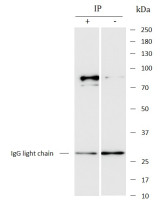ARG44719
anti-PAK4 antibody
anti-PAK4 antibody for IHC-Formalin-fixed paraffin-embedded sections,Immunoprecipitation,Western blot and Human
Overview
| Product Description | Mouse Monoclonal antibody recognizes PAK4 |
|---|---|
| Tested Reactivity | Hu |
| Tested Application | IHC-P, IP, WB |
| Host | Mouse |
| Clonality | Monoclonal |
| Isotype | IgG1 |
| Target Name | PAK4 |
| Antigen Species | Human |
| Conjugation | Un-conjugated |
| Alternate Names | EC 2.7.11.1; p21-activated kinase 4; Serine/threonine-protein kinase PAK 4; PAK-4 |
Application Instructions
| Application Suggestion |
|
||||||||
|---|---|---|---|---|---|---|---|---|---|
| Application Note | * The dilutions indicate recommended starting dilutions and the optimal dilutions or concentrations should be determined by the scientist. |
Properties
| Form | Liquid |
|---|---|
| Purification | Protein A purification |
| Buffer | PBS with 0.09% sodium azide |
| Storage Instruction | For continuous use, store undiluted antibody at 2-8°C for up to a week. For long-term storage, aliquot and store at -20°C or below. Storage in frost free freezers is not recommended. Avoid repeated freeze/thaw cycles. Suggest spin the vial prior to opening. The antibody solution should be gently mixed before use. |
| Note | For laboratory research only, not for drug, diagnostic or other use. |
Bioinformation
| Database Links |
Swiss-port # O96013 Human Serine/threonine-protein kinase PAK 4 |
|---|---|
| Gene Symbol | PAK4 |
| Gene Full Name | p21 protein (Cdc42/Rac)-activated kinase 4 |
| Background | The PAK (p21-activated kinase) family of serine/threonine kinases plays an important role in multiple cellular processes, including cytoskeletal reorganization, MAPK signaling, apoptotic signaling, etc. Several mechanisms that induce PAK activation have been reported. Binding of Rac/cdc42 to the CRIB (or PBD) domain at the N-terminal region of PAK causes autophosphorylation and conformational change of PAK. More recently identified members PAK4, PAK5 and PAK6 have lower sequence similarity with PAK1-3 in the regulatory N-terminal region. It has been demonstrated that phosphorylation of serine 474 of PAK4 may play a pivotal role in the activity and function of PAK4 kinase |
| Function | Serine/threonine protein kinase that plays a role in a variety of different signaling pathways including cytoskeleton regulation, cell migration, growth, proliferation or cell survival. Activation by various effectors including growth factor receptors or active CDC42 and RAC1 results in a conformational change and a subsequent autophosphorylation on several serine and/or threonine residues. Phosphorylates and inactivates the protein phosphatase SSH1, leading to increased inhibitory phosphorylation of the actin binding/depolymerizing factor cofilin. Decreased cofilin activity may lead to stabilization of actin filaments. Phosphorylates LIMK1, a kinase that also inhibits the activity of cofilin. Phosphorylates integrin beta5/ITGB5 and thus regulates cell motility. Phosphorylates ARHGEF2 and activates the downstream target RHOA that plays a role in the regulation of assembly of focal adhesions and actin stress fibers. Stimulates cell survival by phosphorylating the BCL2 antagonist of cell death BAD. Alternatively, inhibits apoptosis by preventing caspase-8 binding to death domain receptors in a kinase independent manner. Plays a role in cell-cycle progression by controlling levels of the cell-cycle regulatory protein CDKN1A and by phosphorylating RAN. [UniProt] |
Images (3) Click the Picture to Zoom In
-
ARG44719 anti-PAK4 antibody IHC-P image
Immunohistochemistry: Human prostate stained with ARG44719 anti-PAK4 antibody at 5 µg/mL dilution.
-
ARG44719 anti-PAK4 antibody WB image
Western blot: HEK293, Jurkat, HeLa, MCF7 stained with ARG44719 anti-PAK4 antibody at 1 µg/mL dilution.
-
ARG44719 anti-PAK4 antibody IP image
Immunoprecipitation: HEK293 lysate immunoprecipitated with 2.5 µg of ARG44719 anti-PAK4 antibody.








